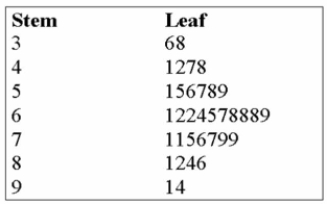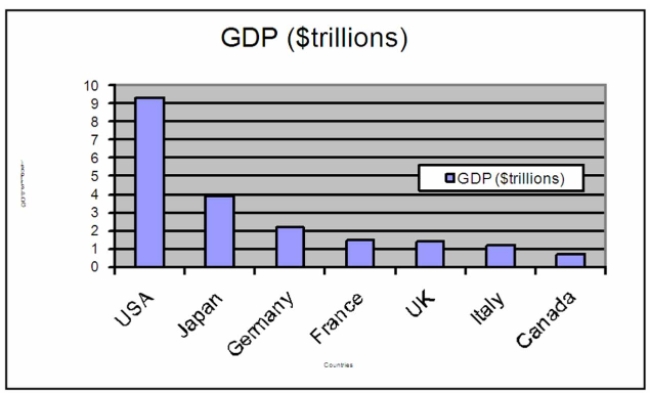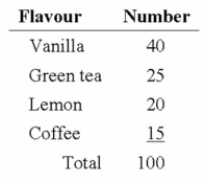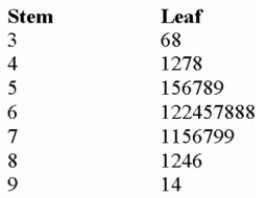A) 30%
B) 50%
C) 20%
D) Cannot be determined.
Correct Answer

verified
Correct Answer
verified
Multiple Choice
When data is collected using a qualitative, nominal variable, i.e., male or female, what is true about a Frequency distribution that summarizes the data?
A) Upper and lower class limits must be calculated.
B) Class midpoints can be computed.
C) Number of classes corresponds to number of the variable's values.
D) The "2 to the k rule" can be applied.
Correct Answer

verified
Correct Answer
verified
Multiple Choice
When a class interval is expressed as: 100 to under 200
A) Observations with values of 100 are excluded from the class frequency.
B) Observations with values of 200 are included in the class frequency.
C) Observations with values of 200 are excluded from the class frequency.
D) The class interval is 99.
Correct Answer

verified
Correct Answer
verified
Multiple Choice
Which is the best (most informative and useful) graphical display of the Average Weekly Earnings Health Care in Canada over the years 2008 to 2012?
A) ![]()
B) ![]()
C) ![]()
D) ![]()
Correct Answer

verified
Correct Answer
verified
Multiple Choice
What is the class midpoint for the class with the greatest frequency?
A) $1400
B) $1500
C) $1600
D) $1700
Correct Answer

verified
Correct Answer
verified
Multiple Choice
(i. A table showing the number of observations that have been grouped into each of several classes Is called a frequency distribution. (ii. When classes in a frequency table are constructed so that data will fit into only one category, it is Called mutually exclusive. (iii) The best means to display data that is based on a trend over a period of time is the polygon.
A) (i) , (ii) and (iii) are all correct statements.
B) (i) , (ii) and (iii) are all false statements.
C) (i) and, (iii) are correct statements but not (ii) .
D) (ii) and (iii) are correct statements but not (i) .
Correct Answer

verified
Correct Answer
verified
Multiple Choice
A sample distribution of hourly earnings in Paul's Cookie Factory is:  The limits of the class with the smallest frequency are:
The limits of the class with the smallest frequency are:
A) $6.00 and $9.00
B) $12.00 and $14.00
C) $11.75 and $14.25
D) $12.00 and $15.00
Correct Answer

verified
Correct Answer
verified
Multiple Choice
Why are unequal class intervals sometimes used in a frequency distribution?
A) To avoid a large number of empty classes
B) For the sake of variety in presenting the data
C) To make the class frequencies smaller
D) To avoid the need for midpoints
Correct Answer

verified
Correct Answer
verified
Multiple Choice
How many employees were absent six or more days?
A) 8
B) 4
C) 22
D) 31
Correct Answer

verified
Correct Answer
verified
Multiple Choice
The following ages (rounded to the nearest whole year) of employees at a large company that were Grouped into a distribution with class limits: 20 up to 30 30 up to 40 40 up to 50 50 up to 60 60 up to 70 (i. The class limits for the class 50 up to 60 class are 50 and 58. (ii. The midpoint for the class 40 up to 50 is 45. (iii) The class interval is 9.
A) (i) , (ii) and (iii) are all correct statements.
B) (i) , (ii) and (iii) are all false statements.
C) (ii) is correct but not not (i) and (iii) .
D) (ii) and (iii) are correct statements but not (i) .
Correct Answer

verified
Correct Answer
verified
Multiple Choice
(i. A table showing the number of observations that have been grouped into each of several classes Is called a frequency distribution. (ii. When classes in a frequency table are constructed so that data will fit into only one category, it is Called a relative class frequency. (iii) The suggested class interval based on number of observations given the data ranges from 100 To 200 with 50 observations is 50.
A) (i) , (ii) and (iii) are all correct statements.
B) (i) , (ii) and (iii) are all false statements.
C) (i) and (iii) are correct statements but not (ii) .
D) (i) is a correct statement but not (ii) or (iii) .
Correct Answer

verified
Correct Answer
verified
Multiple Choice
What percentage of the firms export less than $14 million in product?
A) 3%
B) 6%
C) 49%
D) 94%
E) 75%
Correct Answer

verified
Correct Answer
verified
Multiple Choice
What is the class interval? _____
A) 2
B) 3
C) 3.5
D) 4
Correct Answer

verified
Correct Answer
verified
Multiple Choice
The grades on a statistics exam for a sample of students are as follows:  If A + = 90%-100%
A = 80%-89%
B+ = 75%-79%
B = 70%-74%
C+ = 65%-69%
C = 60%-64%
D = 55%-59%
F = 0%-54%
How many student earned a letter grade of C?
If A + = 90%-100%
A = 80%-89%
B+ = 75%-79%
B = 70%-74%
C+ = 65%-69%
C = 60%-64%
D = 55%-59%
F = 0%-54%
How many student earned a letter grade of C?
A) 1
B) 3
C) 4
D) 5
E) 10
Correct Answer

verified
Correct Answer
verified
Multiple Choice
The chart below shows the Gross Domestic Product for 7 nations. Which of the following statements
Can be determined from this chart? 
A) The GDP of the USA is approximately twice the size of each of the other countries.
B) Germany's GDP is approximately half of that of Japan.
C) Germany's GDP is approximately half of that of Canada.
D) The GDP of the USA is larger than the total GDP of all the other 6 countries combined.
Correct Answer

verified
Correct Answer
verified
Multiple Choice
(i. A frequency table is a grouping of qualitative data into mutually exclusive classes showing the Number of observations in each class. (ii. Simple bar charts may be constructed either horizontally or vertically. (iii) A bar chart is a graphic representation of a frequency table.
A) (i) , (ii) and (iii) are all correct statements.
B) (i) and, (ii) are correct statements but not (iii) .
C) (i) and, (iii) are correct statements but not (ii) .
D) (ii) and, (iii) are correct statements but not (i) .
Correct Answer

verified
Correct Answer
verified
Multiple Choice
Quinn's Café serves ice cream. She asks 100 of her regular customers to take a taste test and pick
The flavour they like the best. The results are shown in the following table.  Is the data quantitative or qualitative? What is the name of the table shown?
Is the data quantitative or qualitative? What is the name of the table shown?
A) quantitative, simple table
B) quantitative, frequency table
C) qualitative, frequency table
D) qualitative, cumulative frequency distribution
E) quantitative, bar chart
Correct Answer

verified
Correct Answer
verified
Multiple Choice
The grades on a statistics exam for a sample of students are as follows:  If A + = 90%-100%
A = 80%-89%
B+ = 75%-79%
B = 70%-74%
C+ = 65%-69%
C = 60%-64%
D+ = 55%-59%
D= 50%-54%
F=0-49%
What is the most common letter grade earned?
If A + = 90%-100%
A = 80%-89%
B+ = 75%-79%
B = 70%-74%
C+ = 65%-69%
C = 60%-64%
D+ = 55%-59%
D= 50%-54%
F=0-49%
What is the most common letter grade earned?
A) A (80%-89%)
B) B (70%-74%)
C) C (60%-64%)
D) D (50%-54%)
E) F (0-49%)
Correct Answer

verified
Correct Answer
verified
Multiple Choice
How many employees were absent fewer than six days?
A) 60
B) 31
C) 91
D) 46
Correct Answer

verified
Correct Answer
verified
Multiple Choice
The grades on a statistics exam for a sample of students are as follows:  If A = 80%-100%
B = 70%-79%
C = 60%-69%
D= 50%-59%
F=0-49%
What is the most common letter grade earned?
If A = 80%-100%
B = 70%-79%
C = 60%-69%
D= 50%-59%
F=0-49%
What is the most common letter grade earned?
A) A (80%-100%)
B) B (70%-79%)
C) C (60%-69%)
D) D (50%-59%)
E) F (0-49%)
Correct Answer

verified
Correct Answer
verified
Showing 61 - 80 of 100
Related Exams